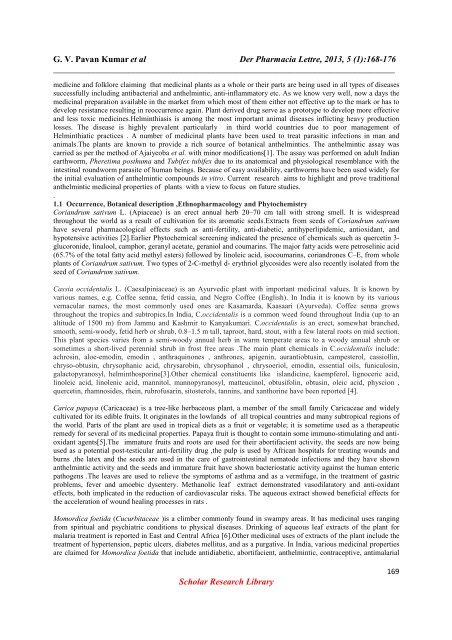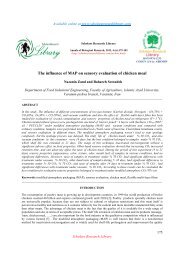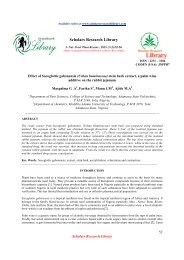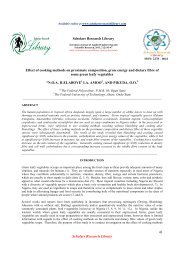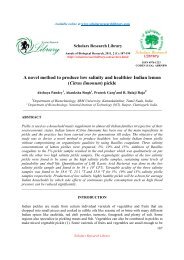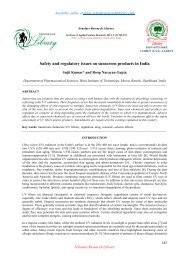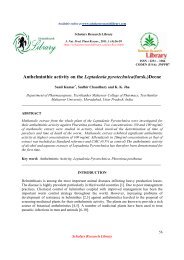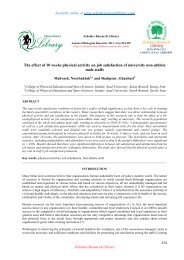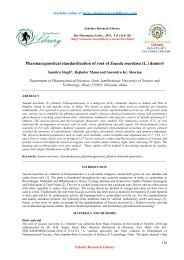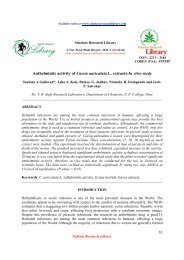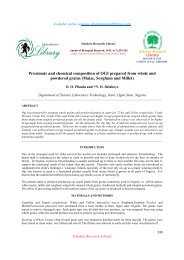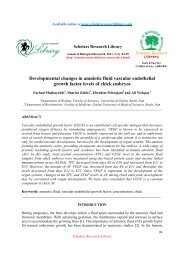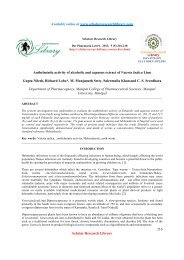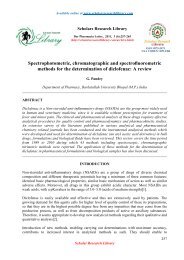Phytochemical analysis, in-vitro screening for antimicrobial and ...
Phytochemical analysis, in-vitro screening for antimicrobial and ...
Phytochemical analysis, in-vitro screening for antimicrobial and ...
Create successful ePaper yourself
Turn your PDF publications into a flip-book with our unique Google optimized e-Paper software.
G. V. Pavan Kumar et al Der Pharmacia Lettre, 2013, 5 (1):168-176<br />
_____________________________________________________________________________<br />
medic<strong>in</strong>e <strong>and</strong> folklore claim<strong>in</strong>g that medic<strong>in</strong>al plants as a whole or their parts are be<strong>in</strong>g used <strong>in</strong> all types of diseases<br />
successfully <strong>in</strong>clud<strong>in</strong>g antibacterial <strong>and</strong> anthelm<strong>in</strong>tic, anti-<strong>in</strong>flammatory etc. As we know very well, now a days the<br />
medic<strong>in</strong>al preparation available <strong>in</strong> the market from which most of them either not effective up to the mark or has to<br />
develop resistance result<strong>in</strong>g <strong>in</strong> reoccurrence aga<strong>in</strong>. Plant derived drug serve as a prototype to develop more effective<br />
<strong>and</strong> less toxic medic<strong>in</strong>es.Helm<strong>in</strong>thiasis is among the most important animal diseases <strong>in</strong>flict<strong>in</strong>g heavy production<br />
losses. The disease is highly prevalent particularly <strong>in</strong> third world countries due to poor management of<br />
Helm<strong>in</strong>thiatic practices . A number of medic<strong>in</strong>al plants have been used to treat parasitic <strong>in</strong>fections <strong>in</strong> man <strong>and</strong><br />
animals.The plants are known to provide a rich source of botanical anthelm<strong>in</strong>tics. The anthelm<strong>in</strong>tic assay was<br />
carried as per the method of Ajaiyeoba et al. with m<strong>in</strong>or modifications[1]. The assay was per<strong>for</strong>med on adult Indian<br />
earthworm, Pheretima posthuma <strong>and</strong> Tubifex tubifex due to its anatomical <strong>and</strong> physiological resemblance with the<br />
<strong>in</strong>test<strong>in</strong>al roundworm parasite of human be<strong>in</strong>gs. Because of easy availability, earthworms have been used widely <strong>for</strong><br />
the <strong>in</strong>itial evaluation of anthelm<strong>in</strong>tic compounds <strong>in</strong> <strong>vitro</strong>. Current research aims to highlight <strong>and</strong> prove traditional<br />
anthelm<strong>in</strong>tic medic<strong>in</strong>al properties of plants with a view to focus on future studies.<br />
.<br />
1.1 Occurrence, Botanical description ,Ethnopharmacology <strong>and</strong> Phytochemistry<br />
Cori<strong>and</strong>rum sativum L. (Apiaceae) is an erect annual herb 20–70 cm tall with strong smell. It is widespread<br />
throughout the world as a result of cultivation <strong>for</strong> its aromatic seeds.Extracts from seeds of Cori<strong>and</strong>rum sativum<br />
have several pharmacological effects such as anti-fertility, anti-diabetic, antihyperlipidemic, antioxidant, <strong>and</strong><br />
hypotensive activities [2].Earlier <strong>Phytochemical</strong> screen<strong>in</strong>g <strong>in</strong>dicated the presence of chemicals such as quercet<strong>in</strong> 3-<br />
glucoronide, l<strong>in</strong>alool, camphor, geranyl acetate, geraniol <strong>and</strong> coumar<strong>in</strong>s. The major fatty acids were petrosel<strong>in</strong>ic acid<br />
(65.7% of the total fatty acid methyl esters) followed by l<strong>in</strong>oleic acid, isocoumar<strong>in</strong>s, cori<strong>and</strong>rones C–E, from whole<br />
plants of Cori<strong>and</strong>rum sativum. Two types of 2-C-methyl d- erythriol glycosides were also recently isolated from the<br />
seed of Cori<strong>and</strong>rum sativum.<br />
Cassia occidentalis L. (Caesalp<strong>in</strong>iaceae) is an Ayurvedic plant with important medic<strong>in</strong>al values. It is known by<br />
various names, e.g. Coffee senna, fetid cassia, <strong>and</strong> Negro Coffee (English). In India it is known by its various<br />
vernacular names, the most commonly used ones are Kasamarda, Kaasaari (Ayurveda). Coffee senna grows<br />
throughout the tropics <strong>and</strong> subtropics.In India, C.occidentalis is a common weed found throughout India (up to an<br />
altitude of 1500 m) from Jammu <strong>and</strong> Kashmir to Kanyakumari. C.occidentalis is an erect, somewhat branched,<br />
smooth, semi-woody, fetid herb or shrub, 0.8–1.5 m tall, taproot, hard, stout, with a few lateral roots on mid section.<br />
This plant species varies from a semi-woody annual herb <strong>in</strong> warm temperate areas to a woody annual shrub or<br />
sometimes a short-lived perennial shrub <strong>in</strong> frost free areas .The ma<strong>in</strong> plant chemicals <strong>in</strong> C.occidentalis <strong>in</strong>clude:<br />
achros<strong>in</strong>, aloe-emod<strong>in</strong>, emod<strong>in</strong> , anthraqu<strong>in</strong>ones , anthrones, apigen<strong>in</strong>, aurantiobtus<strong>in</strong>, campesterol, cassioll<strong>in</strong>,<br />
chryso-obtus<strong>in</strong>, chrysophanic acid, chrysarob<strong>in</strong>, chrysophanol , chrysoeriol, emod<strong>in</strong>, essential oils, funiculos<strong>in</strong>,<br />
galactopyranosyl, helm<strong>in</strong>thospor<strong>in</strong>e[3].Other chemical constituents like isl<strong>and</strong>ic<strong>in</strong>e, kaempferol, lignoceric acid,<br />
l<strong>in</strong>oleic acid, l<strong>in</strong>olenic acid, mannitol, mannopyranosyl, matteuc<strong>in</strong>ol, obtusifol<strong>in</strong>, obtus<strong>in</strong>, oleic acid, physcion ,<br />
quercet<strong>in</strong>, rhamnosides, rhe<strong>in</strong>, rubrofusar<strong>in</strong>, sitosterols, tann<strong>in</strong>s, <strong>and</strong> xanthor<strong>in</strong>e have been reported [4].<br />
Carica papaya (Caricaceae) is a tree-like herbaceous plant, a member of the small family Caricaceae <strong>and</strong> widely<br />
cultivated <strong>for</strong> its edible fruits. It orig<strong>in</strong>ates <strong>in</strong> the lowl<strong>and</strong>s of all tropical countries <strong>and</strong> many subtropical regions of<br />
the world. Parts of the plant are used <strong>in</strong> tropical diets as a fruit or vegetable; it is sometime used as a therapeutic<br />
remedy <strong>for</strong> several of its medic<strong>in</strong>al properties. Papaya fruit is thought to conta<strong>in</strong> some immuno-stimulat<strong>in</strong>g <strong>and</strong> antioxidant<br />
agents[5].The immature fruits <strong>and</strong> roots are used <strong>for</strong> their abortifacient activity, the seeds are now be<strong>in</strong>g<br />
used as a potential post-testicular anti-fertility drug ,the pulp is used by African hospitals <strong>for</strong> treat<strong>in</strong>g wounds <strong>and</strong><br />
burns ,the latex <strong>and</strong> the seeds are used <strong>in</strong> the care of gastro<strong>in</strong>test<strong>in</strong>al nematode <strong>in</strong>fections <strong>and</strong> they have shown<br />
anthelm<strong>in</strong>tic activity <strong>and</strong> the seeds <strong>and</strong> immature fruit have shown bacteriostatic activity aga<strong>in</strong>st the human enteric<br />
pathogens .The leaves are used to relieve the symptoms of asthma <strong>and</strong> as a vermifuge, <strong>in</strong> the treatment of gastric<br />
problems, fever <strong>and</strong> amoebic dysentery. Methanolic leaf extract demonstrated vasodilatatory <strong>and</strong> anti-oxidant<br />
effects, both implicated <strong>in</strong> the reduction of cardiovascular risks. The aqueous extract showed beneficial effects <strong>for</strong><br />
the acceleration of wound heal<strong>in</strong>g processes <strong>in</strong> rats .<br />
Momordica foetida (Cucurbitaceae )is a climber commonly found <strong>in</strong> swampy areas. It has medic<strong>in</strong>al uses rang<strong>in</strong>g<br />
from spiritual <strong>and</strong> psychiatric conditions to physical diseases. Dr<strong>in</strong>k<strong>in</strong>g of aqueous leaf extracts of the plant <strong>for</strong><br />
malaria treatment is reported <strong>in</strong> East <strong>and</strong> Central Africa [6].Other medic<strong>in</strong>al uses of extracts of the plant <strong>in</strong>clude the<br />
treatment of hypertension, peptic ulcers, diabetes mellitus, <strong>and</strong> as a purgative. In India, various medic<strong>in</strong>al properties<br />
are claimed <strong>for</strong> Momordica foetida that <strong>in</strong>clude antidiabetic, abortifacient, anthelm<strong>in</strong>tic, contraceptive, antimalarial<br />
Scholar Research Library<br />
169


